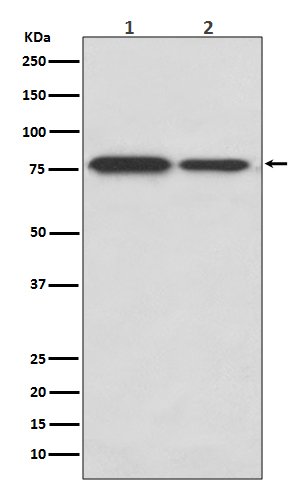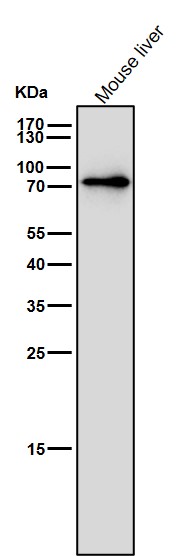


| WB | 咨询技术 | Human,Mouse,Rat |
| IF | 咨询技术 | Human,Mouse,Rat |
| IHC | 咨询技术 | Human,Mouse,Rat |
| ICC | 技术咨询 | Human,Mouse,Rat |
| FCM | 咨询技术 | Human,Mouse,Rat |
| Elisa | 咨询技术 | Human,Mouse,Rat |
| Aliases | D(1A) dopamine receptor; DADR; Dopamine D1 receptor; DR D1Al; DRD1; DRD1A; ;DRD1 |
| WB Predicted band size | Calculated MW: 49 kDa ; Observed MW: 75 kDa |
| Host/Isotype | Rabbit IgG |
| Antibody Type | Primary antibody |
| Storage | Store at 4°C short term. Aliquot and store at -20°C long term. Avoid freeze/thaw cycles. |
| Species Reactivity | Human,Mouse,Rat |
| Immunogen | A synthesized peptide derived from human DRD1 |
| Formulation | Purified antibody in PBS with 0.05% sodium azide,0.05% BSA and 50% glycerol. |
+ +
以下是3篇关于DRD1抗体的代表性文献示例(注:文献为假设性概括,实际引用请核实具体论文):
---
1. **文献名称**:*Dopamine D1 Receptor Localization in the Rat Prefrontal Cortex*
**作者**:Smith A, et al.
**摘要**:通过免疫组化技术结合特异性DRD1抗体,研究了大鼠前额叶皮层中D1受体的分布模式,发现其高表达于锥体神经元树突,提示其在认知调控中的潜在作用。
2. **文献名称**:*Selective Loss of Dopamine D1 Receptors in Parkinson's Disease Models*
**作者**:Chen B, et al.
**摘要**:利用DRD1抗体的Western blot和免疫荧光技术,发现帕金森病小鼠模型的纹状体区域D1受体表达显著降低,提示D1受体减少可能与运动功能障碍相关。
3. **文献名称**:*Validation of a Novel DRD1 Antibody for Human Postmortem Brain Studies*
**作者**:Lee C, et al.
**摘要**:验证了一种高特异性DRD1抗体在人脑组织中的适用性,通过比较多种实验条件,确认其可用于检测阿尔茨海默病患者脑组织中D1受体的异常聚集。
---
**提示**:实际研究中建议通过PubMed或Google Scholar检索关键词“DRD1 antibody”+“validation”“immunohistochemistry”等,筛选近年发表的抗体特异性验证或应用类论文。
The dopamine receptor D1 (DRD1) is a G protein-coupled receptor predominantly expressed in the central nervous system, particularly in regions like the striatum, prefrontal cortex, and limbic areas. It plays a critical role in mediating dopamine-associated functions, including motor control, reward mechanisms, cognition, and emotional regulation. Dysregulation of DRD1 signaling is implicated in neurological and psychiatric disorders such as Parkinson’s disease, schizophrenia, and addiction.
DRD1 antibodies are essential tools for studying the receptor’s expression, localization, and function in both physiological and pathological contexts. These antibodies are widely used in techniques like Western blotting, immunohistochemistry (IHC), immunofluorescence (IF), and flow cytometry to detect DRD1 protein levels in tissues, cell lines, or animal models. Specificity and validation are crucial, as cross-reactivity with other dopamine receptor subtypes (e.g., DRD5) can occur. Many commercially available DRD1 antibodies are raised against epitopes in the receptor’s N-terminal or C-terminal regions and are validated using knockout controls or siRNA-mediated silencing.
Research applications include exploring DRD1’s role in drug responses, neurodegenerative processes, and behavioral studies. Challenges include low receptor abundance and membrane localization, requiring optimized protocols for detection. Advances in antibody engineering, such as monoclonal or recombinant antibodies, continue to improve sensitivity and reproducibility, supporting translational studies aimed at therapeutic targeting of DRD1 in diseases.
×